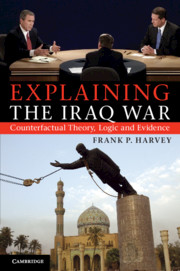Book contents
- Frontmatter
- Contents
- Figures
- Tables
- Acknowledgments
- Introduction
- 1 Comparative counterfactual analysis and the 2003 Iraq war
- 2 Leadership, political context(s) and the Iraq war
- 3 Democratic national security advisers
- 4 Domestic and congressional politics
- 5 American intelligence failures and miscalculations
- 6 Societal pressures and public opinion
- 7 International politics, global WMD consensus and UN power balancing
- 8 Hussein’s mistakes, miscalculations and misperceptions
- 9 Summary and implications
- 10 Conclusion
- Bibliography
- Index
4 - Domestic and congressional politics
Published online by Cambridge University Press: 05 June 2012
- Frontmatter
- Contents
- Figures
- Tables
- Acknowledgments
- Introduction
- 1 Comparative counterfactual analysis and the 2003 Iraq war
- 2 Leadership, political context(s) and the Iraq war
- 3 Democratic national security advisers
- 4 Domestic and congressional politics
- 5 American intelligence failures and miscalculations
- 6 Societal pressures and public opinion
- 7 International politics, global WMD consensus and UN power balancing
- 8 Hussein’s mistakes, miscalculations and misperceptions
- 9 Summary and implications
- 10 Conclusion
- Bibliography
- Index
Summary
This chapter explores the powerful political motivations that inspired officials in Washington, regardless of political affiliation, to shape the post-9/11 and Iraq WMD contexts. The objective is to highlight the significant role leaders in the Democratic Party played in constructing public perceptions of the Iraq threat. Further, the significant bipartisan consensus that characterized relevant debates during this time period will reveal the power of prevailing perceptions regarding Saddam, Iraq, WMD, and ultimately the appropriate strategies for tackling such important foreign policy issues.
Among the most relevant political speeches are those delivered by every prominent Democratic senator in October 2002 justifying their strong endorsement of the resolution authorizing the president to use ‘all necessary means’ to force Saddam’s compliance. The same group of senators would have been in power had Gore been elected president in 2000 and would have faced identical domestic pressures after 9/11 to craft similar speeches on Iraq. In fact, as noted earlier, the speeches read much like those delivered by many of the same senators in 1998 when voting 98–0 in support of the Iraq Liberation Act. There was really only one dominant perspective on the Iraq threat at the time, and neoconservatives were not relevant to establishing that standard point of view.
- Type
- Chapter
- Information
- Explaining the Iraq WarCounterfactual Theory, Logic and Evidence, pp. 126 - 146Publisher: Cambridge University PressPrint publication year: 2011

